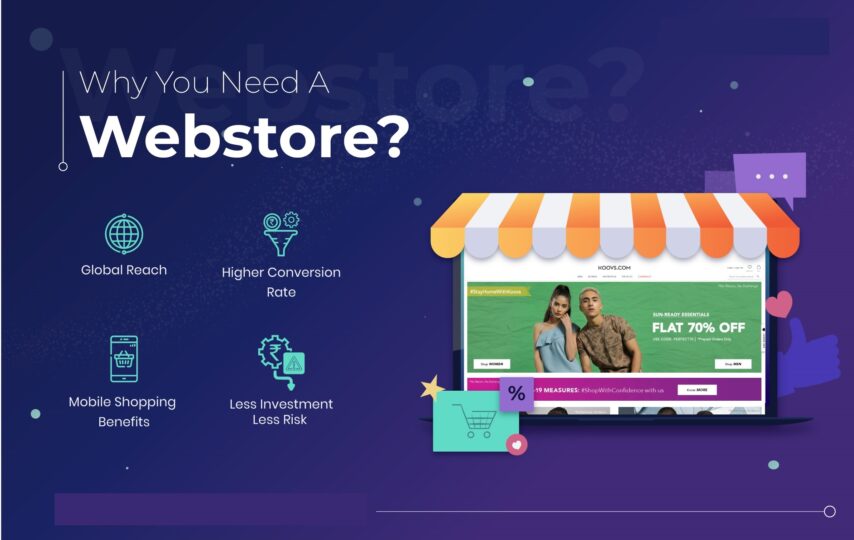eCommerce is a growing trend due to the convenience and accessibility offered by the internet, which allows people to shop from the comfort of their own homes. Many businesses have moved from traditional brick-and-mortar stores to online platforms, making eCommerce a popular choice for both consumers and entrepreneurs. Many companies provide their expertise only in eCommerce website design and services to support the rise of eCommerce.
Why Online Business Better than Offline Business
1.Reach a Wider Customer Base: An ecommerce website allows your business to reach a wider customer base beyond geographical limitations. Your website can be accessible 24/7, 365 days a year, making it convenient for customers to shop at any time.
2.Increased Sales and Revenue: By having an online presence, your business can reach a larger number of customers and increase sales and revenue. Ecommerce websites are often more user-friendly than traditional brick-and-mortar stores, making it easier for customers to find what they’re looking for and complete a purchase.
3.Cost-Effective: Setting up an ecommerce website is much more cost-effective than opening a physical store. You can save on rent, utilities, and other overhead costs associated with traditional retail stores.
4.Better Analytics and Insights: Ecommerce websites come equipped with powerful analytics and insights tools that can help you understand customer behavior, preferences, and purchasing patterns. These insights can be used to make data-driven decisions that improve your overall business strategy.
5.Improved Customer Experience: A well-designed and optimized ecommerce website can provide customers with a better shopping experience, making them more likely to return and become repeat customers. This can help drive customer loyalty and increase brand recognition.
Let’s have a Look on Top 4 Benefits of eCommerce Business
- Automatic Data Collection
Ecommerce websites use various tools and techniques to automatically collect data in order to streamline their operations and provide a better user experience. Some of the ways ecommerce websites help in automatic data collection are:
- Cookies: Ecommerce websites use cookies to store information about a customer’s browsing and purchasing history, which helps in personalizing the shopping experience and making recommendations based on their preferences.
- Web Analytics: Ecommerce websites use web analytics tools like Google Analytics to track customer behavior on their website, such as the pages they visit, the items they add to their cart, and the checkout process.
- Shopping Cart Software: Ecommerce websites use shopping cart software to store information about the customer’s order, such as their name, address, and payment information. This data is used to process the order and also to generate sales reports and customer behavior analysis.
- Customer Feedback Forms: Ecommerce websites use customer feedback forms to collect data on customer satisfaction, product quality, and customer service. This information can be used to improve the customer experience and to resolve any issues that customers may have.
- Sales Data: Ecommerce websites collect sales data automatically by tracking the number of items sold, the revenue generated, and the average order value. This data is used to monitor the performance of the website and to make informed business decisions.
By automating the data collection process, ecommerce websites can save time, reduce errors, and improve the overall customer experience.
2.How online retail businesses track ROI
1.Website Analytics: By analyzing website traffic data and conversion rates, online retailers can measure their return on investment and determine what strategies are driving their sales. This can be done through tools like Google Analytics, which tracks user behavior and conversion rates.
2.Cost Per Acquisition (CPA): By tracking the cost of acquiring a customer and comparing it to the revenue generated by that customer, retailers can determine their ROI. This includes advertising costs, website costs, and other marketing expenses.
3.Customer Lifetime Value (CLV): CLV is a prediction of the total amount of money a customer will spend with a company over the course of their lifetime. By determining CLV, online retailers can estimate their ROI from each customer and make informed decisions about how to allocate their resources.
4.A/B Testing: Online retailers can conduct A/B tests to determine which marketing strategies and tactics are most effective in driving sales and generating ROI. By randomly exposing a portion of visitors to different versions of their website or marketing messages, they can determine which approach is more effective and adjust their strategies accordingly.
5.Inventory Management: By monitoring inventory levels and sales data, retailers can determine which products are selling well and which ones are not. This information can be used to make informed decisions about which products to keep in stock, which to discontinue, and which to source more of.
6.Return on Advertising Spend (ROAS): ROAS is a metric that measures the return on investment from advertising spend. By tracking the revenue generated from advertising campaigns and comparing it to the cost of the campaign, retailers can determine their ROI from each advertising channel.
3. Different Marketing Strategy for Online Business
1.Email marketing: Online retailers send targeted email campaigns to their subscribers, offering special discounts, promotions, and new product releases.
2.Social media advertising: Retailers experiment with different social media advertising strategies, such as sponsored posts, influencer marketing, and video ads to reach a wider audience and drive sales.
3.Search engine optimization: Retailers use keywords, meta tags, and other SEO techniques to improve their search engine rankings, making it easier for customers to find their products online.
4.Referral marketing: Retailers encourage customers to refer their friends and family members to their store, either through referral codes or incentivized programs.
5.Content marketing: Retailers create and publish blog posts, videos, and other types of content to educate and engage their customers, and drive traffic to their store.
6.Influencer marketing: Retailers partner with popular influencers in their industry to promote their products and reach a wider audience.
7.Pop-up advertisements: Retailers experiment with different pop-up advertisements, such as exit-intent pop-ups and timed pop-ups, to convert visitors into customers.
8.Affiliate marketing: Retailers partner with affiliates who promote their products and earn a commission on each sale.
9.Mobile optimization: Retailers experiment with different mobile optimization techniques, such as responsive design, mobile-friendly layouts, and mobile-specific promotions, to improve their mobile experience and drive sales.
4. How online retail business can identify which products are in trends
1.Data analysis: Retailers can gather data on product sales, customer search history, and social media mentions to identify trends in customer preferences. This information can help them predict which products are likely to be in demand in the future.
2.Social media monitoring: Retailers can track hashtags, mentions, and discussions related to their products on social media platforms like Instagram, Twitter, and Facebook to see which products are being talked about the most.
3.Competitor research: Retailers can monitor the product offerings of their competitors to see which products are in high demand. They can also compare their own product offerings to those of their competitors to identify gaps in their product line.
4.Industry reports and forecasts: Retailers can stay up-to-date on industry trends by reading market reports and forecasts from industry associations and research firms. This will give them an idea of which products are expected to be in high demand in the future.
5.Customer feedback: Retailers can ask their customers for feedback on their products to get a sense of which items are most popular. They can also use customer reviews to see what people are saying about their products.
Many online businesses are opting for custom ecommerce development as it allow businesses to have complete control over their online store, with the ability to add or remove features as needed. This gives businesses the flexibility to create a user-friendly and engaging experience for their customers.
Custom ecommerce development also provides businesses with more control over the look and feel of their store. This means that businesses can create a store that truly reflects their brand, helping to increase brand recognition and customer loyalty. Additionally, custom ecommerce development enables businesses to integrate their store with their existing systems and processes, making it easier to manage orders, inventory, and other important aspects of their business.
Another advantage of custom ecommerce development is that it provides businesses with better security. Custom ecommerce solutions can be designed with security features built in, such as encryption and secure socket layer (SSL) certificates, to protect sensitive customer information. This helps to keep customer data safe, reducing the risk of fraud and other security breaches.
Overall, custom ecommerce development is a valuable investment for businesses looking to grow their online presence and take their business to the next level. With the ability to tailor their online store to meet their specific needs and enhance their brand, Companies like MoreCustomersApp that pioneer in ecommerce website development can help businesses achieve success in the digital marketplace.








